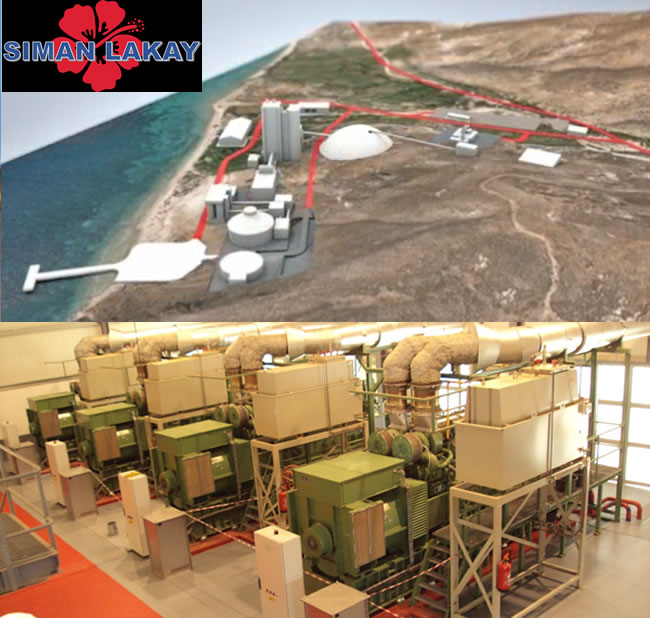ADVERTISEMENT
Home - House in Haiti
Cement plant in Gonaives, Siman Lakay
Here is a picture of the cement plant in Gonaives, Siman Lakay
In an article published (August 2012 issue) in the Global Cement Magazine, it was said that Haiti is blessed with natural limestone, essential to produce good quality cement. However, so far Haiti was deprived of its natural advantage because there was no proper infrastructure or any investor to fund and realize such advantage. There is good news. With 'Siman Lakay', a $300 million project, Haiti can produce a good part of its requirements (4.5 million tons per year) and generate enough employment (about 2,200) of diversified skills. 'Siman Lakay' is a new cement plant, has a production capacity of 2 million tons per annum, going to be built in the "La Pierre" locality of Gonaives. The project has come into existence after more than one year's hard work and technical studies by Mr. Bestgen Jérôme, the Honorary Consul of Haiti in Belgium, and it could never have been possible without the support of foreign and Haitian investors.
Veerhouse Voda plant opens in Drouillard, Haiti
Opening of a Veerhouse Voda plant in Drouillard.
Veerhouse Voda is a New York based company that has worked over 22 projects in Haiti in the last three years. The company is flexible to fit all building needs. It provides a large variety of building structures with a combination of lightweight steel frames (expanded Polystyrene panel) which cost less but resistant to earthquake, fire, hurricane, flood and other natural disasters. As per new report dated September 14, the company has opened a production plant of Expanded Polystyrene (EPS) panel in Drouillard (West Department) for its local consumption. The new plant, as per the company's statement, would create over 2,000 direct and indirect jobs.
Former mansion of Beaudoin Jacques Ketant
Here is a picture of the former mansion of Beaudoin "Jacques" Ketant located in Petion-Ville.
Drug Informant Jacques Ketant Gets Reduced Sentence.
Jacques Ketant, serving time in a U.S. prison for drug smuggling, has had his sentence reduced from 27 to 13 1/2 years. Ketant turned informant for the U.S. Attorney's office, ratting on Haitian government officials involved in the drug trade.
He transported 30-plus tons of cocaine through Haiti for 12 years. He alleges bribing former Haitian President Aristide, but following the U.S. Justice Department's investigation he was cleared of all wrong doing.
Old Cuban consulate, Villa Paula, haunted house in Little Haiti
Here is the picture of a house located in Little Haiti in Miami. This beautiful mansion located at 5811 N. Miami Avenue is an old Cuban consulate, Villa Paula but also is one of the haunted houses in Little Haiti.
Old Cuban Consulate, Villa Paula, Haunted House in Little Haiti
The Villa Paula since 1989 has been named the most haunted building in Miami. It was built in 1925 and the first inhabitants were Senior Don Domigo Milode and his wife Paula. Six years after they moved in, Paula died of an unfortunate complication that arose during her leg amputation. Ever since paranormal activities have been reported at the Villa. There have been reports of unexplainable knocking of the front door, mysterious death of cats, clamping of heels in the backyard and even to the extent of sightings of Paula. The Villa with all its beautiful Cuban decors is since the 90s is preferably left unoccupied, at least after sunset.
Housing units in Morne Lazarre, Haiti
Here is a picture of the Housing units in Morne Lazarre.
President Michel Martelly accompanied by the Executive Director of the Housing Construction Unit and Public Buildings (UCLBP) visited the new housing site in Morne Lazarre, Bourdon Road to hand over the keys to the victims of 16 neighborhoods from the metropolitan area of Port-au-Prince which were destroyed by the earthquake of January 12, 2010. The earthquake flattened the poor hillside neighborhood, leaving only a school building standing as a place of refuge. The project has been built on an area of 2,270 square meters and includes 25 family residential units in two and three levels. Fourteen of these residential units have an area of 60 square meters, five have an area of 70 square meters and six are about 50 square meters area, each. The construction has been completed within 16 months (December 2013 to 16 April 2015) under joint funding of the Haiti Reconstruction Fund (HRF) and the American Red Cross of US$.900000 and executed by the United Nations Office for Project Services.
Training of Haitian masons in earthquake-resistant construction
Here are some Haitian masons receiving training on earthquake-resistant construction
On Wednesday, March 18, 2015, under a UNDP's (United Nations Development Program) earthquake prevention plan, the National Institute for Professional Training (INFP) and the Swiss Cooperation with financial assistance from the Fund for Reconstruction of Haiti (FRH), launched the Phase II Training Program of earthquake-resistant construction for 220 masons from the northern departments of the Northeast and Northwest. The program was initially launched in 2012 and so far a total of 37 engineers, both from public and private sectors and 24 foremen have been trained in earthquake-resistant construction with necessary knowledge on the seismic assessment of buildings so that they can prepare Haiti with safe and sustainable construction to avoid risk of future disasters.
Grain bins from Iowa turned into homes in Haiti
Here is a picture where creativity is used to help those in need. Grain bins from Iowa used to make homes in Haiti after the 2010 earthquake
Iowa-based company, Global Compassion Network, has been doing work in Haiti for the past three years to restore many of those displaced by the 2010 earthquake, back into homes. These dwelling residencies are made from grain bins -- round metal bins, which have been recycled to form what the group calls 'safe homes.' The project takes place in the village called Hope, and so far, some 220 people have benefitted from the 60 homes already erected. The project is done with help from the Sukup Manufacturing company.
World Vision's Sant Lespwa of Hope near Hinche wins architectural award
Here is a picture of World Vision's Sant Lespwa of Hope located near the city of Hinche. Rothschild Doyno Collaborative received the award from The American Institute of Architects for the design
The Sant Lespwa Center of Hope, located outside of Hinche, Haiti, has garnered the team an award for architecture in the 2015 AIA Honor Awards. Commissioned by World vision, the center was built with the Haitian breeze in mind, with the building giving over to a breezeway that allows the light and wind in, and also gives astounding views of the nearby mountains. The scope of the brilliance of the architecture also involves water collection, the generation of electricity, and consideration of the treatment of sewage. All these plans were made with the input of the community, and the building also provided the training of over a hundred locals.
Michel Martelly Opens Administrative Complex Center in Hinche
President Martelly attended the inaugural of the Administrative Complex Center (ACC) in Hinche. The modern design complies with green standards, and will house government offices.
Inter-American Development Bank (IADB) funded the $2,670,000 project. ACC is only one of several projects IADB has subsidized since the earthquake.
Martelly spoke of a work culture, in which Haitians would receive an immediate response to their issues. He emphasized harmony, so everyone would see Haiti as serious about improving its image and be viewed as a stable democracy.
Francois C. Antoine Simon
The 18th Haitian President François C. Antoine Simon was born on October 10, 1843. As a President, his first and most important policy decision was to introduce an appeasement policy that allowed many exiled Haitians to return homeland. He realized that Haiti can be self sufficient only if the agricultural production of sugar and banana can be increased and export can be boosted. He understood the necessity of infrastructural connectivity through railway network. But unfortunately his dream never materialized due to lack of sponsor. Because, his poorly prepared negotiation agreement with the foreign financiers had many conditional issues on repayment which were unattractive to the bankers. In contrast, his plans instead of bringing benefits created more evils--to satisfy American planters, Haitian banana growers were taxed; electrification and paving of the streets of the capital city increased the import bill through increased number of imported cars. The political unrest became so serious that his once minister, General Cincinnatus Leconte, took advantage of the situation and lead a coup d'état against him. The General succeeded on his second attempt to oust President Simon from power.











 Should birthright citizenship be eliminated in the US?
Should birthright citizenship be eliminated in the US?  Petion-Ville, Haiti
Petion-Ville, Haiti  François Nicolas Duvalier Potential Candidate for President of...
François Nicolas Duvalier Potential Candidate for President of...  Rafael L. Trujillo welcoming Paul Magloire in Santo Domingo
Rafael L. Trujillo welcoming Paul Magloire in Santo Domingo  Haitiano-Japanese Naomi Osaka wins the US Open against Serena...
Haitiano-Japanese Naomi Osaka wins the US Open against Serena...  Pope Francis appointed Mgr. Launay Saturne Archbishop of...
Pope Francis appointed Mgr. Launay Saturne Archbishop of...  Philippe Vorbe entered world football Hall of Fame, CONCACAF
Philippe Vorbe entered world football Hall of Fame, CONCACAF  Partial list of privileges enjoyed by Government officials in...
Partial list of privileges enjoyed by Government officials in... 



